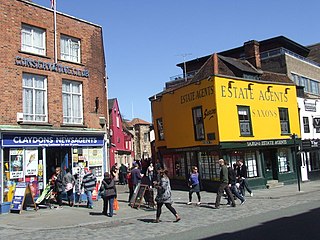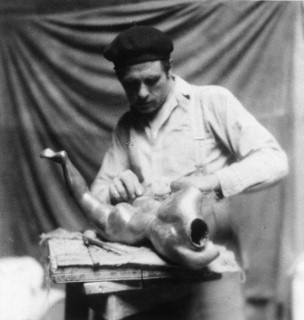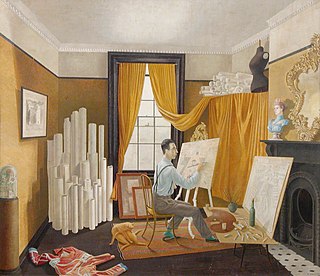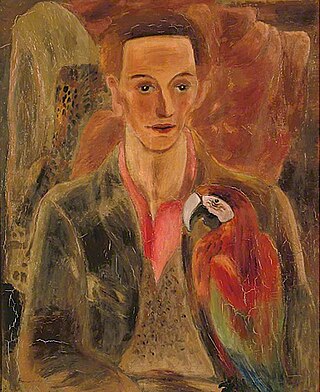
Colchester is a city in Essex, England. It is the third-largest settlement in the county, with a population of 130,245 at the 2021 Census. The demonym is Colcestrian.

George Claude Leon Underwood was a British artist, although primarily known as a sculptor, printmaker and painter, he was also an influential teacher and promotor of African art. His travels in Mexico and West Africa had a substantial influence on his art, particularly on the representation of the human figure in his sculptures and paintings. Underwood is best known for his sculptures cast in bronze, carvings in marble, stone and wood and his drawings. His lifetime's work includes a wide range of media and activities, with an expressive and technical mastery. Underwood did not hold modernism and abstraction in art in high regard and this led to critics often ignoring his work until the 1960s when he came to be viewed as an important figure in the development of modern sculpture in Britain.
John Northcote Nash was a British painter of landscapes and still-lives, and a wood engraver and illustrator, particularly of botanic works. He was the younger brother of the artist Paul Nash.

Edward Bawden, was an English painter, illustrator and graphic artist, known for his prints, book covers, posters, and garden metalwork furniture. Bawden taught at the Royal College of Art, where he had been a student, worked as a commercial artist and served as a war artist in World War II. He was a fine watercolour painter but worked in many different media. He illustrated several books and painted murals in both the 1930s and 1960s. He was admired by Edward Gorey, David Gentleman and other graphic artists, and his work and career is often associated with that of his contemporary Eric Ravilious.
James Henry Cecil Collins MBE was an English painter and printmaker, originally associated with the Surrealist movement.

Sir Cedric Lockwood Morris, 9th Baronet was a British artist, art teacher and plantsman. He was born in Swansea in South Wales, but worked mainly in East Anglia. As an artist he is best known for his portraits, flower paintings and landscapes.
Stanley Clifford-Smith (1906–1968) was an English Expressionist painter and textile designer who was active as an artist in the 1940s, 1950s and 1960s.
Timothy Hyman is a British figurative painter, art writer and curator. He has published monographs on both Sienese Painting and on Pierre Bonnard, as well as most recently The World New Made: Figurative Painting in the Twentieth Century. He has written extensively on art and film, has been a regular contributor to The Times Literary Supplement (TLS) and has curated exhibitions at the Tate, Institute of Contemporary Arts and Hayward galleries. Hyman is a portraitist, but is best known for his narrative renditions of London. Drawing inspiration from artists such as Max Beckmann and Bonnard, as well as Lorenzetti and Brueghel, he explores his personal relationship, both real and mythological, with the city where he lives and works. He employs vivid colours, shifting scale and perspectives, to create visionary works. He was elected an RA in 2011.
Nigel Graeme Henderson (1 April 1917 – 15 May 1985) was an English documentary artist, and photographer.

Firstsite is a visual arts organisation based in Colchester, Essex, which opened in 1993 as Colchester and District Visual Arts Trust, changing its name to Firstsite in 1995. Its current building was opened in 2011. It was the national Art Fund's Museum of the Year in 2021. The building Firstsite occupies as a tenant was designed by Rafael Viñoly and the freehold is retained by Colchester Council. The building is situated in Colchester's "Cultural Quarter" near The Minories, Colchester, fifteen Queen Street, the Norman Colchester Castle, the Natural History Museum, Hollytrees Museum and Colchester's Roman Wall.

The Minories is a Grade II listed building and gardens situated at the east end of High Street in Colchester, Essex, England, near Hollytrees, Gate House and Colchester Castle. It currently houses The Minories Galleries which are no longer run by Colchester School of Art, part of Colchester Institute.
Bernard Reynolds (1915–1997) was an esteemed East Anglian artist with a special interest in sculpting. He was born in Norwich and lived for almost fifty years in Ipswich. For although Reynolds is most widely known as a sculptor, he possessed the capacity to be an inspirational teacher as well as an artist, and he fulfilled both of these roles with his own particular kind of integrity. Reynolds was characterised for his quietly rigorous self-imposed discipline to every project he undertook – and due to his multiple pursuits, his projects were many and varied.
Roderic Barrett (1920–2000) was a British painter from Colchester, England.
Colin William Moss was a British artist and teacher who served as a camouflage designer during World War Two.
James Dodds is an East Anglian artist whose practice centers on painting, linocut and relief carving. Born in Brightlingsea, Essex, he now lives and works in Wivenhoe producing prints and books as the Jardine Press. He is the son of East Anglian artist Andrew Dodds and has been described as "boatbuilding’s artist laureate".
Elisabeth Jessie Vellacott was an English painter working on figures and narrative landscapes. In her later work she often painted on wooden board rather than canvas and she had her first solo exhibition at the age of 63 before working long into her 90s.
Colchester Art Society was founded in 1946 by a group of artists who lived in Colchester and the nearby areas, many of whom were also linked to the Colchester School of Art, which is part of Colchester Institute. The aim of the society was and still is the promotion of the visual arts.

Simon Carter is an English artist and curator.

Amanda Ansell is an English artist. She studied Fine Art at Norwich University of the Arts between 1995 and 1998 and then at the Slade School of Fine Art, University College London from 1998 to 2000. After living in London for seven years, she returned to her native Suffolk in 2006 to begin an artist residency at Firstsite, Colchester. The same year, a body of work was selected for exhibition at Kettles Yard, Cambridge and she was nominated for Jerwood Contemporary Painters.
Eva Lucy Harwood was a British artist known for her landscape paintings of East Anglia and Suffolk.












